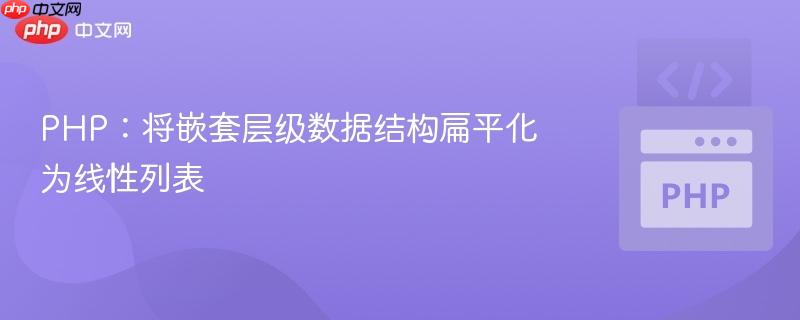
本文详细介绍了如何将复杂的php嵌套层级数据结构(如带有`children`属性的分类树)转换为一个简单的、不含层级关系的扁平化列表。教程涵盖了将php对象转换为可操作数组的通用方法,并提供了一个高效的递归函数来遍历并提取所有节点,最终生成一个易于处理的线性数组。
在许多应用中,数据常以树形或层级结构存储,例如商品分类、部门组织等。这种结构通常通过在每个节点中包含一个children(子节点)数组来实现嵌套。
考虑以下一个典型的PHP对象结构,其中Categories_store_tree对象包含一个私有属性list_of_sections,该属性本身是一个根分类节点,并递归地包含其子分类:
object(Categories_store_tree)#519 (1) {
["list_of_sections":"Categories_store_tree":private]=> array(5) {
["id"]=> int(1)
["name"]=> string(11) "Main Store"
["parent_id"]=> NULL
["children"]=> array(2) {
[0]=> array(5) {
["id"]=> int(2)
["name"]=> string(4) "Food"
["parent_id"]=> int(1)
["children"]=> array(0) { }
}
[1]=> array(5) {
["id"]=> int(3)
["name"]=> string(14) "Electronics"
["parent_id"]=> int(1)
["children"]=> array(2) {
[0]=> array(5) {
["id"]=> int(4)
["name"]=> string(8) "Headphones"
["parent_id"]=> int(3)
["children"]=> array(0) { }
}
[1]=> array(5) {
["id"]=> int(5)
["name"]=> string(5) "Smartphones"
["parent_id"]=> int(3)
["children"]=> array(0) { }
}
}
}
}
}
}我们的目标是将这种复杂的嵌套结构转换为一个简单的、扁平化的列表。在这个列表中,每个分类(无论其原始层级如何)都将作为顶级数组的一个元素,并且不再包含children键。
期望的输出结构如下:
立即学习“PHP免费学习笔记(深入)”;
object(Categories_store_tree)#964 (1) {
["list_of_sections":"Categories_store_tree":private]=> array(5) {
[0]=> array(4) {
["id"]=> int(1)
["name"]=> string(11) "Main Store"
["parent_id"]=> NULL
}
[1]=> array(4) {
["id"]=> int(2)
["name"]=> string(4) "Food"
["parent_id"]=> int(1)
}
[2]=> array(4) {
["id"]=> int(3)
["name"]=> string(14) "Electronics"
["parent_id"]=> int(1)
}
[3]=> array(4) {
["id"]=> int(4)
["name"]=> string(8) "Headphones"
["parent_id"]=> int(3)
}
[4]=> array(4) {
["id"]=> int(5)
["name"]=> string(5) "Smartphones"
["parent_id"]=> int(3)
}
}
}核心挑战在于如何遍历所有层级的节点,提取其核心数据(id, name, parent_id),并将其收集到一个新的线性数组中。
如果你的原始数据是一个PHP对象,特别是当它包含私有或保护属性时,直接操作可能比较困难。首先,我们需要一个通用的方法将整个对象(包括其所有嵌套的对象和数组)转换为一个纯粹的PHP数组。这使得后续的扁平化操作更加便捷。
以下是一个可以递归处理对象和数组,并能访问私有/保护属性的objectToArrayRecursive函数:
<?php
/**
* 递归地将对象(包括私有/保护属性)转换为数组
*
* @param mixed $obj 待转换的对象或数组
* @return array 转换后的数组
*/
function objectToArrayRecursive($obj) {
if (is_object($obj)) {
$arr = [];
$reflection = new ReflectionClass($obj);
foreach ($reflection->getProperties() as $prop) {
$prop->setAccessible(true); // 使私有/保护属性可访问
$arr[$prop->getName()] = objectToArrayRecursive($prop->getValue($obj));
}
return $arr;
} elseif (is_array($obj)) {
// 如果是数组,则递归处理其所有元素
return array_map(__FUNCTION__, $obj);
} else {
// 否则直接返回非对象/非数组的值
return $obj;
}
}
?>这个函数利用PHP的ReflectionClass来访问对象的私有和保护属性,确保所有数据都能被正确地提取和转换。
在将对象转换为数组之后,下一步是实现核心的扁平化逻辑。我们将使用一个递归函数来遍历层级结构,提取每个节点的数据,并将其添加到最终的扁平化列表中。
<?php
/**
* 递归地将层级分类数组扁平化为线性列表
*
* @param array $node 待处理的当前分类节点
* @param array $flatList 引用传递的扁平化列表,用于收集所有节点
*/
function flattenCategories(array $node, array &$flatList) {
// 复制当前节点,并移除 'children' 键,因为扁平化列表中不需要它
$cleanNode = $node;
unset($cleanNode['children']);
// 将清理后的节点添加到扁平化列表
$flatList[] = $cleanNode;
// 如果当前节点有子节点,则递归处理它们
if (isset($node['children']) && is_array($node['children'])) {
foreach ($node['children'] as $child) {
flattenCategories($child, $flatList);
}
}
}
?>flattenCategories 函数接收两个参数:当前正在处理的节点数组和对最终扁平化列表的引用。它首先创建一个当前节点的副本,移除children键,然后将这个“干净”的节点添加到$flatList中。接着,如果存在子节点,它会遍历这些子节点并对每个子节点递归调用自身。
为了演示上述步骤的结合使用,我们首先需要模拟一个Categories_store_tree对象。由于Categories_store_tree是一个自定义类,并且其list_of_sections属性是私有的,我们需要一个该类的定义来创建实例。
<?php
// 模拟 Categories_store_tree 类
class Categories_store_tree {
private $list_of_sections;
public function __construct(array $data) {
$this->list_of_sections = $data;
}
// 假设有一个方法可以设置或获取 private 属性,或者我们直接使用反射来操作
public function setListOfSections(array $data) {
$this->list_of_sections = $data;
}
public function getListOfSections() {
return $this->list_of_sections;以上就是PHP:将嵌套层级数据结构扁平化为线性列表的详细内容,更多请关注php中文网其它相关文章!

PHP怎么学习?PHP怎么入门?PHP在哪学?PHP怎么学才快?不用担心,这里为大家提供了PHP速学教程(入门到精通),有需要的小伙伴保存下载就能学习啦!

Copyright 2014-2025 https://www.php.cn/ All Rights Reserved | php.cn | 湘ICP备2023035733号